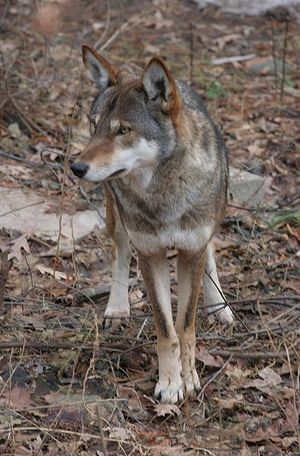Debate on Numbers
Some debate exists over how many species of wolves exist. Sources will list anywhere from two to six. This does not include the occasional addition of Canis familiaris (the domestic dog). In fact, the only type of wolf that has little to no debate over its species status is Canis lupus, the gray wolf. The gray wolf has the largest population (there are more than 8.000 of these in Alaska) and several subspecies.
The red wolf (Canis rufus) gets second place for most agreed upon its “true wolf” status. However, there are some scientists that argue the red wolf is really a mix of gray wolf and coyote although such a mixture would have occurred long ago. The Ethiopian wolf (Canis simensis) is sometimes listed as a third species, one that’s even “universally recognized”. Despite this, there are several who argue the Ethiopian wolf is jackal or simply a close relative to the wolf.
The eastern wolf (sometimes the eastern timber wolf) has argument circling over its status. Some say it should be classified as a separate species Canis lycaon. Others say it is a subspecies of gray wolf and should be classified as Canis lupus lycaon.
Other wolves sometimes listed are Canis indica (Indian Wolf) and Canis himalayansis (Himalayan wolf). The Indian wolf was once clumped together with the Iranian wolf (Canis lupus pallipes). However, modern research suggests that Canis indica has not been mixed or interbred with another species in over 400,000 years. This fact of information is one of the indicators scientists use to identify distinct species. Both the Himalayan wolf and the Indian wolf have been previously classified as subspecies of the gray wolf.
The Gray Wolf
The gray wolf is the largest member of the canis species. They grow to roughly six feet long and weight from eighty to one hundred pounds. The gray wolf is found in North America, Europe, and Asia. In North America their range includes parts of Canada, Alaska, Minnesota, and Wyoming (Yellowstone).
The Red Wolf
The red wolf is a small population with about 150 to 200 members of the species left in existence. This is a large increase from 1975 when there were only about seventeen pure red wolves left. This is due to an extensive recovery program. Currently, the only place to find a red wolf (outside of a zoo or facility) is in North Carolina on the Albemarle Peninsula in the northeastern part of the state.
The red wolf is smaller than the gray with a longer snout and slighter build. They rarely get above seventy pounds.
The Eastern Wolf
A recent announcement (may 2011) from the U.S. Fish and Wildlife Service included a discussion listing the Eastern Wolf as its own unique species. This has come as a surprise to many because it was not previously clear that this was the stance taken on lycaon’s classification. The gray wolf and eastern wolf look almost exactly alike with similar behavior and roles in their ecosystems. Even their territory tends to overlap. It is only through in-depth genetic study that the differences have been seen.
The Ethiopian Wolf
The Ethiopian wolf lives in mountain habitats in the Ethiopian highlands. Their coats are a bold reddish rust color with white markings on the throat, underside, and sometimes paws. Compared to most wolves they are small, measuring only about four and half feet long and weighing only about forty pounds. Spotted hyenas will sometimes make off with the wolves’ pups.
The Indian and Himalayan Wolves
The Indian wolf lives in grasslands throughout several states in India. In 2004, there were approximately three to four thousand left in the wild.
The ranges of Indian and Himalayan wolves often overlap. The Himalayan wolf was at one point thought to be a variant of the Tibetan wolf (Canis lupus chanco). The two are very similar and told apart based upon genetics and history. They are shorter than most wolves and live in smaller packs (typically only 2-3).
A Note:
Science is ever discovering new methods. Remember that classification is something humans do, and thus there’s argument to be had in the process.
Sources and Other:
Greeley, Maureen Wolf Barnes & Nobel, Inc. 1997.
“Lupine Evolution, Species, and Subspecies” Wolfhowl.org, written May 2010, accessed June 2011
Marien, Catherine “Wolf Breeds” The Canine Information Library 2010, accessed June 2011
“Wolves of the World” Cosmosmith 1999-2011 accessed June 2011
Edberg, Jess “What exactly, is the FWS proposing?” June 2011, accessed June 2011 International Wolf Center
“Tibetan Wolf” Absolute Astronomy , accessed June 2011





